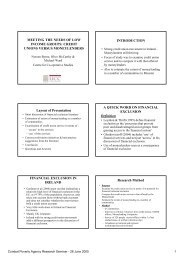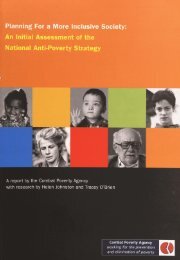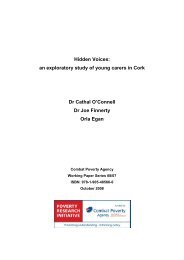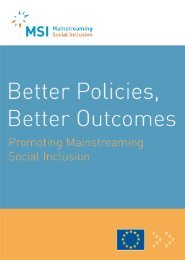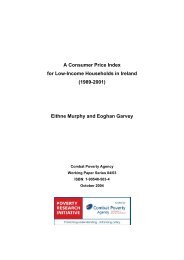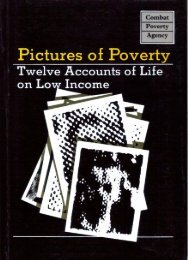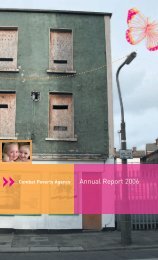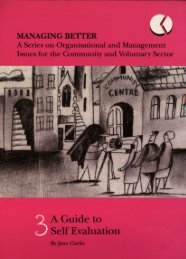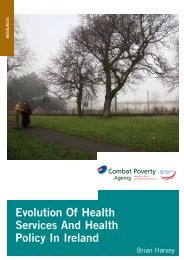The Distribution of Income in Ireland (2000) - Combat Poverty Agency
The Distribution of Income in Ireland (2000) - Combat Poverty Agency
The Distribution of Income in Ireland (2000) - Combat Poverty Agency
- No tags were found...
You also want an ePaper? Increase the reach of your titles
YUMPU automatically turns print PDFs into web optimized ePapers that Google loves.
74 <strong>The</strong> <strong>Distribution</strong> <strong>of</strong> <strong>Income</strong> <strong>in</strong> <strong>Ireland</strong>biased technical change and globalisation and competitionfrom develop<strong>in</strong>g countries. Here we look at returns to educationand changes <strong>in</strong> the educational pr<strong>of</strong>ile <strong>of</strong> employees <strong>in</strong> theIrish case, and the extent to which this may have contributed to<strong>in</strong>creas<strong>in</strong>g earn<strong>in</strong>gs dispersion. <strong>The</strong> fact that this <strong>in</strong>crease <strong>in</strong>earn<strong>in</strong>gs <strong>in</strong>equality has not been experienced to anyth<strong>in</strong>g likethe same extent <strong>in</strong> some other <strong>in</strong>dustrialised countries has als<strong>of</strong>ocused attention on the role <strong>of</strong> <strong>in</strong>stitutional factors such as centralisedwage barga<strong>in</strong><strong>in</strong>g and m<strong>in</strong>imum wage legislation. Wetherefore also po<strong>in</strong>t to some relevant features <strong>of</strong> the Irish <strong>in</strong>stitutionalbackground.Dur<strong>in</strong>g the 1980s and <strong>in</strong>to the 1990s, there has been a rapidrise <strong>in</strong> the level <strong>of</strong> educational atta<strong>in</strong>ment <strong>of</strong> those leav<strong>in</strong>g theIrish education system. This reflects substantially higher numberscomplet<strong>in</strong>g full second-level education rather than leav<strong>in</strong>gearly, and a marked <strong>in</strong>crease <strong>in</strong> the proportion go<strong>in</strong>g on tothird-level education. As cohorts conta<strong>in</strong><strong>in</strong>g a high proportionwith relatively low levels <strong>of</strong> education retire and those withrelatively high levels enter the labour force, this has producedthe rather dramatic change <strong>in</strong> the education pr<strong>of</strong>ile <strong>of</strong> employeesbetween 1987 and 1994 shown <strong>in</strong> Table 6.4. Whereas <strong>in</strong>1987 28 per cent <strong>of</strong> employees did not have a formal qualificationbeyond primary level, by 1994 this had fallen to 17 percent. This was accompanied by a rise <strong>in</strong> the percentage withpost-secondary school atta<strong>in</strong>ment levels from 18 per cent to 24per cent. We now go on to explore the relationship betweenthis chang<strong>in</strong>g education pr<strong>of</strong>ile and the distribution <strong>of</strong> earn<strong>in</strong>gs.Table 6.4: Education Atta<strong>in</strong>ment Level, <strong>Ireland</strong> 1987 andHighest Qualification AchievedPrimary onlyJunior cycleLeav<strong>in</strong>g Cert.Certificate/DiplomaJJegreeAll<strong>The</strong> <strong>Distribution</strong> <strong>of</strong> Earn<strong>in</strong>gs 75Table 6.5 looks first at median earn<strong>in</strong>gs by education categoryand how this evolved between 1987 and 1994. <strong>The</strong> greatestpercentage <strong>in</strong>crease over the period was for those with universitydegrees, for whom the median rose by 52 per cent, comparedwith 30-38 per cent for the other atta<strong>in</strong>ment levels. <strong>The</strong>table also looks at dispersion with<strong>in</strong> education categories, <strong>in</strong>terms <strong>of</strong> the ratio <strong>of</strong> the top to the bottom decile. This measureshows that the degree <strong>of</strong> dispersion was widest with<strong>in</strong> the postschoolnon-degree category <strong>in</strong> each year, but rose considerablywith<strong>in</strong> the bottom and the top education categories between1987 and 1994.Table 6.5: Median Hourly Earn<strong>in</strong>gs and Ratio <strong>of</strong> Top toBottom Decile by Education Category, All Employees, 1987and 1994 (IR£ per hour)Primary onlyJunior cycleLeav<strong>in</strong>g CertificateDiploma/other thirdlevelDegree'AiPMedian19873.753.834.355.488.404.30Median19945.005.285.687.2312.785.98%Increase33.337.930.632.952.139.1Top Decile/Bottom Decile19872.733.443.804.563.234.1619943.163.863.764.733.904.77With the balance between men and women <strong>in</strong> the workforcechang<strong>in</strong>g, it is also <strong>in</strong>terest<strong>in</strong>g to look at male and female employeesseparately. <strong>The</strong> educational pr<strong>of</strong>ile <strong>of</strong> male and femaleemployees changed <strong>in</strong> very much the same way as that for allemployees. Although a higher proportion <strong>of</strong> men than womenhad only primary-level qualifications, this decl<strong>in</strong>ed very rapidlyfor both, and the percentage with post-school qualificationsalso rose substantially for both men and women. <strong>The</strong> relativelyrapid <strong>in</strong>crease <strong>in</strong> median hourly earn<strong>in</strong>gs between 1987 and!994 for those with university degrees was also seen bothamong men and women, and the same is true <strong>of</strong> the consider-




